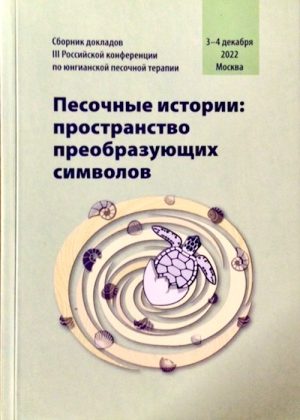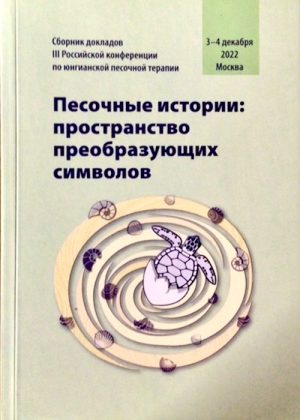My Store
Sand Stories: A Space of Transformative Symbols
Sand Stories: A Space of Transformative Symbols
Couldn't load pickup availability
Collection of papers from the Third Russian Conference on Jungian Sandplay Therapy, December 3-4, 2022.
Content
Introduction
Elena Purtova
The Magic of Blue
Elena Zakharova
You can't stay home
Analysis of the initial stage of therapy of a cross-cultural 8-year-old child.
Victoria Andreeva
Orphan Complex
Clinical case.
Olga Kondratova
The shield as a guide to integrity
Vera Povetkina
Possibilities of group Sendplay therapy in extreme situations.
Elena Sheveleva
Yurt - Imago Mundi of a nomad
Transformation and individuation in sand wanderings.
Anna Kucheryavenko
The work of the transcendent function in the integration of masculine and feminine elements in the Sendplay process
Tatyana Soboleva
Mountain symbol
Development of a symbol in the sand process of a seven-year-old boy.
Natalia Dovgaya
The Unsolved Mystery of the Malachite Box
Chaos and structure in the sandbox.
Anna Borodkina
Emerging from the depths to rise to the sky
Dolphin symbolism in culture and sandbox.
Victoria Fribus
Transformation of the image of the path
The image of the railway in Sandplay therapy
From the editors
DEAR COLLEAGUES!
We are pleased to present a collection of articles from the Third Russian Conference on Jungian Sandplay Therapy, "Sand Stories: A Space of Transformative Symbols," which took place in Moscow on December 3-4, 2022. Against the backdrop of difficult global events, we created an opportunity to share experiences, learn, and connect with like-minded individuals. Two intense days and two participation formats filled the space with symbols of the times, broadened understanding of the method, deepened theoretical knowledge, and introduced its practical application in work. These annual meetings foster regular and intensive training in the method.
Participation in conferences of leading Russian analytical psychologists – supervisors of the Russian Association of Analytical Psychologist/IAAP – has become a good tradition.
Elena Purtova presented a report titled "The Magic of Blue," which explored color from various perspectives and perspectives within the external and internal worlds, as well as the nuances of perception and the full correlation with the sensory-emotional realm of shades of blue.
Victoria Andreeva's report, "The Orphan Complex," demonstrated the complex's characteristic features, its norm and pathology, as well as the specifics of its manifestation and therapy in the sand, its imagery, symbolic analysis, games, and nuances of interpretation in working with a boy caught up in this complex as a result of the early trauma of abandonment.
Olga Kondratova's presentation, "The Shield as a Guide to Integrity," offered an in-depth analysis of the symbol using a clinical case study with a client as an example. Participants had the opportunity to see the stages of analysis through the stages of symbol transformation.
Elena Zakharova and Vera Povetkina presented presentations reflecting the challenges and traumas of our time. Elena Zakharova shared her extensive experience working with children who have fled their homes, demonstrating the challenges they face and ways to overcome the crisis. Vera Povetkina discussed the potential of Sandplay therapy for working with refugees. A distinctive feature of this approach was that the therapy was conducted not individually, as is most often the case in Sandplay, but with a group of children. Vera shared how to create opportunities for group processes and provide crisis psychological support to children and parents. We were able to explore the themes and images of sandboxes chosen by children who had arrived from conflict zones and lost their homes, relatives, and country.
There were two reports on the transcendental function: Svetlana
Salnik discusses Sendpley and Anna Kucheryavenko's distinctive characteristic of integrating masculine and feminine elements. The transcendental function represents a complex connection between the real world and the imaginary, the rational and the irrational, thus creating a bridge between the conscious and the unconscious. The colleagues demonstrated the function's operation through sandbox imagery.
In her presentation, Natalia Dovgaya linked Bazhov's fairy tale with the process of Sendplay therapy for a six-year-old girl, showing a case of a child's inability to cope with intense emotional reactions in situations of failure or rejection and restrictions from adults.
As usual, the conference allowed participants to enrich themselves with amplifications of images from their colleagues' sandplay therapy. Victoria Fribus conducted a master class on the symbolism of the railway, allowing us to experience ourselves as travelers on this mode of transport through time and space. Anna Borodkina expanded on the image of the dolphin, deeply immersing the audience in this interesting and multi-meaningful symbol. And Tatyana Soboleva presented a presentation on the image of a mountain, using a clinical example from her work with a seven-year-old boy.
Despite the challenges, the conference participants included analytical psychologists from many countries: Belarus, Latvia, Kazakhstan, Slovenia, Hungary, the Czech Republic, Armenia, Israel, Thailand, Germany, and Turkey. One of the conference's goals was networking and collaboration, and we are delighted that the conference's geographic reach is expanding. Among the Russian colleagues were psychologists from Moscow and St. Petersburg, Tver, Krasnodar, Maykop, Perm, Ufa, Chita, Belgorod, Yekaterinburg, Ulyanovsk, Penza, Vladivostok, and Novosibirsk.
The organizers thank everyone who supported the conference and the publication of this collection through their participation and charitable donations during this difficult time for everyone.
Looking forward to further cooperation,
Elena Roshchupkina and Victoria Andreeva
Share

